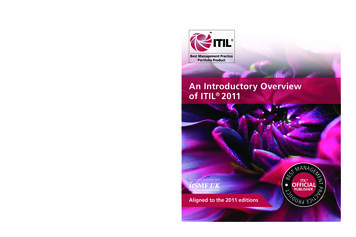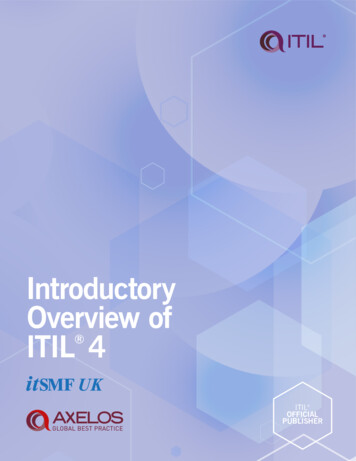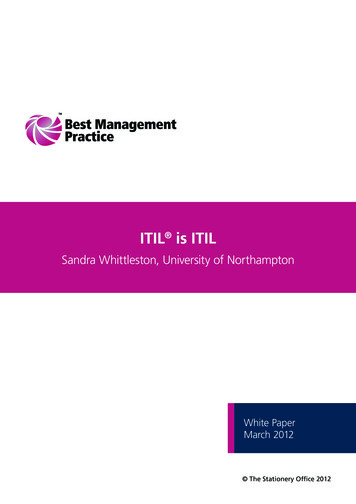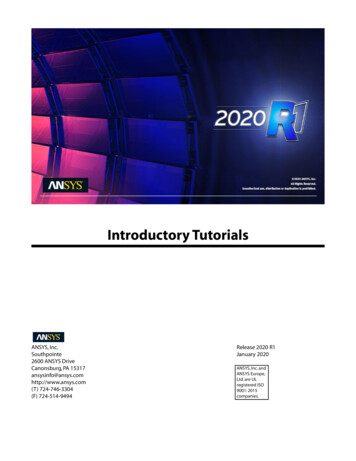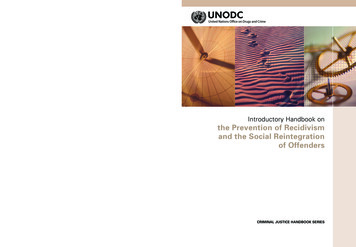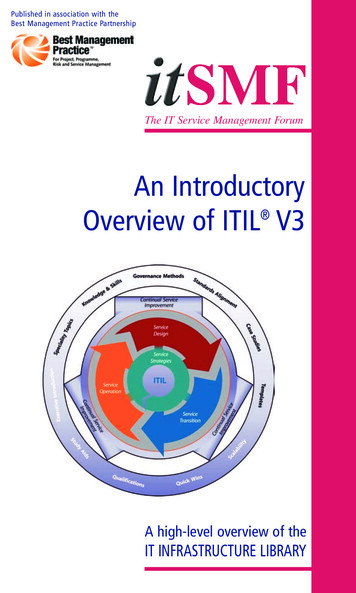
Transcription
Published in association with theBest Management Practice PartnershipThe IT Service Management ForumAn IntroductoryOverview of ITIL V3A high-level overview of theIT INFRASTRUCTURE LIBRARY
The IT Infrastructure LibraryAn IntroductoryOverview of ITIL V3Version 1.0Written by:Alison CartlidgeAshley HannaColin RuddIvor MacfarlaneJohn WindebankStuart RanceXansa - SteriaHPitEMS LtdIBMSunHPEdited by:Alison CartlidgeMark LillycropXansa - SteriaitSMF UKPublished by:The UK Chapter of the itSMFWith thanks to all those who took part in the review process. Copyright itSMF Ltd, 2007This version first published 2007Based on other copyright material with the permission of the copyrightowners.ITIL is a Registered Trade Mark, and a Registered Community Trade Mark,of the Office of Government Commerce (OGC) and is registered in the USPatent and Trade Mark Office.PRINCE is a Registered Trade Mark, and a Registered Community TradeMark, of the Office of Government Commerce (OGC) and is registered in theUS Patent and Trade Mark Office.COBIT is a Registered Trade Mark of ISACA and the ITGA.CMM is registered in the USA Patent and Trademark Office.PMBoK is a Registered Trade Mark of the Project Management Institute.M o R is a Registered Trade Mark and a Registered Community TradeMark of the Office of Government Commerce. Crown copyright material reproduced with the kind permission of OGC onbehalf of the Controller of Her Majesty’s Stationery Office (HMSO).The Swirl logoTM is a Trademark of the Office of Government Commerce.ISBN 0-9551245-8-11
About this guideITIL (IT Infrastructure Library) provides a framework of Best Practiceguidance for IT Service Management and since its creation, ITIL has grown tobecome the most widely accepted approach to IT Service Management in theworld.This pocket guide has been designed as an introductory overview for anyonewho has an interest in or a need to understand more about the objectives,content and coverage of ITIL. Whilst this guide provides an overview, fulldetails can be found in the actual ITIL publications themselves.This guide describes the key principles of IT Service Management and providesa high-level overview of each of the core publications within ITIL:IService StrategyIService DesignIService TransitionIService OperationIContinual Service Improvement.An overview of the qualifications scheme is also included.The advice contained within this guide is neither definitive nor prescriptive, butis based on ITIL Best Practice. The guidance in the ITIL publications isapplicable generically and is of benefit to all IT organizations irrespective oftheir size or the technology in use. It is neither bureaucratic nor unwieldy ifutilized sensibly and in full recognition of the business needs of theorganization.2
ContentsAbout this Guide2Contents31 Introduction42 What is Service Management?63 What is ITIL?84 Service Strategy125 Service Design186 Service Transition247 Service Operation298 Continual Service Improvement359 Process Cross Reference4110 Qualifications4311 Related Standards and Other Sources4712 Summary49Further Guidance and Contact Points51Best Practice within ITIL52About itSMF53About the Partnership543
1 IntroductionIt has become increasingly recognized that information is the most importantstrategic resource that any organization has to manage. Key to the collection,analysis, production and distribution of information within an organization isthe quality of the IT Services provided to the business. It is essential that werecognize that IT Services are crucial, strategic, organizational assets andtherefore organizations must invest appropriate levels of resource into thesupport, delivery and management of these critical IT Services and the ITsystems that underpin them. However, these aspects of IT are often overlookedor only superficially addressed within many organizations.Key issues facing many of today’s senior Business Managers and IT Managersare:IIT and business strategic planningIIntegrating and aligning IT and business goalsIImplementing continual improvementIMeasuring IT organization effectiveness and efficiencyIOptimizing costs and the Total Cost of Ownership (TCO)IAchieving and demonstrating Return on Investment (ROI)IDemonstrating the business value of ITIDeveloping business and IT partnerships and relationshipsIImproving project delivery successIOutsourcing, insourcing and smart sourcingIUsing IT to gain competitive advantageIDelivering the required, business justified IT services (i.e. what is required,when required and at an agreed cost)IManaging constant business and IT changeIDemonstrating appropriate IT governance.The challenges for IT managers are to co-ordinate and work in partnership withthe business to deliver high quality IT services. This has to be achieved whileadopting a more business and customer oriented approach to deliveringservices and cost optimization.4
The primary objective of Service Management is to ensure that the IT servicesare aligned to the business needs and actively support them. It is imperativethat the IT services underpin the business processes, but it is also increasinglyimportant that IT acts as an agent for change to facilitate businesstransformation.All organizations that use IT depend on IT to be successful. If IT processes andIT services are implemented, managed and supported in the appropriate way,the business will be more successful, suffer less disruption and loss ofproductive hours, reduce costs, increase revenue, improve public relations andachieve its business objectives.Key sections within this guide:ISection 4 overviews Service Strategy: The achievement of strategic goals orobjectives requires the use of strategic assets. The guidance shows how totransform service management into a strategic asset.ISection 5 overviews Service Design: guidance on designing IT services,along with the governing IT practices, processes and policies, to realize thestrategy and facilitate the introduction of services into the live environmentensuring quality service delivery, customer satisfaction and cost-effectiveservice provision.ISection 6 overviews Service Transition: guidance for the development ofcapabilities for transitioning new and changed services into operations,ensuring the requirements of Service Strategy, encoded in Service Design,are effectively realized in Service Operations while controlling the risks offailure and disruption.ISection 7 overviews Service Operation: guidance on achieving effectivenessand efficiency in the delivery and support of services to ensure value forthe customer and the service provider. Strategic objectives are ultimatelyrealized through Service Operations.ISection 8 overviews Continual Service Improvement: guidance in creatingand maintaining value for customers through better design, introductionand operation of services, linking improvement efforts and outcomes withService Strategy, Design, Transition and Operation.ISection 10 Qualifications provides an outline of the current and proposedqualification scheme.5
2 What is IT Service Management?To understand what service management is, we need to understand whatservices are, and how service management can help service providers to deliverand manage these services.A service is a means of delivering value to customers byfacilitating outcomes customers want to achieve without theownership of specific costs and risks.A simple example of a customer outcome that could be facilitated by an ITservice might be: “Sales people spending more time interacting withcustomers” facilitated by “a remote access service that enables reliable accessto corporate sales systems from sales people’s laptops”.The outcomes that customers want to achieve are the reason why they purchaseor use the service. The value of the service to the customer is directly dependenton how well it facilitates these outcomes. Service management is what enablesa service provider to understand the services they are providing, to ensure thatthe services really do facilitate the outcomes their customers want to achieve, tounderstand the value of the services to their customers, and to understand andmanage all of the costs and risks associated with those services.Service Management is a set of specialized organizationalcapabilities for providing value to customers in the form ofservices.These “specialized organizational capabilities” are described in this pocketguide. They include all of the processes, methods, functions, roles and activitiesthat a Service Provider uses to enable them to deliver services to theircustomers.Service management is concerned with more than just delivering services. Eachservice, process or infrastructure component has a lifecycle, and servicemanagement considers the entire lifecycle from strategy through design andtransition to operation and continual improvement.6
The inputs to service management are the resources and capabilities thatrepresent the assets of the service provider. The outputs are the services thatprovide value to the customers.Effective service management is itself a strategic asset of the service provider,providing them with the ability to carry out their core business of providingservices that deliver value to customers by facilitating the outcomes customerswant to achieve.Adopting good practice can help a service provider to create an effective servicemanagement system. Good practice is simply doing things that have beenshown to work and to be effective. Good practice can come from many differentsources, including public frameworks (such as ITIL, COBIT and CMMI),standards (such as ISO/IEC 20000 and ISO 9000), and proprietary knowledgeof people and organizations.7
3 What is ITIL?ITIL is a public framework that describes Best Practice in IT servicemanagement. It provides a framework for the governance of IT, the ‘servicewrap’, and focuses on the continual measurement and improvement of thequality of IT service delivered, from both a business and a customerperspective. This focus is a major factor in ITIL’s worldwide success and hascontributed to its prolific usage and to the key benefits obtained by thoseorganizations deploying the techniques and processes throughout theirorganizations. Some of these benefits include:Iincreased user and customer satisfaction with IT servicesIimproved service availability, directly leading to increased business profitsand revenueIfinancial savings from reduced rework, lost time, improved resourcemanagement and usageIimproved time to market for new products and servicesimproved decision making and optimized risk.IITIL was published between 1989 and 1995 by Her Majesty’s Stationery Office(HMSO) in the UK on behalf of the Central Communications andTelecommunications Agency (CCTA) – now subsumed within the Office ofGovernment Commerce (OGC). Its early use was principally confined to theUK and Netherlands. A second version of ITIL was published as a set ofrevised books between 2000 and 2004.The initial version of ITIL consisted of a library of 31 associated books coveringall aspects of IT service provision. This initial version was then revised andreplaced by seven, more closely connected and consistent books (ITIL V2)consolidated within an overall framework. This second version becameuniversally accepted and is now used in many countries by thousands oforganizations as the basis for effective IT service provision. In 2007, ITIL V2was superseded by an enhanced and consolidated third version of ITIL,consisting of five core books covering the service lifecycle, together with theOfficial Introduction.8
The five core books cover each stage of the service lifecycle (Figure 1), from theinitial definition and analysis of business requirements in Service Strategy andService Design, through migration into the live environment within ServiceTransition, to live operation and improvement in Service Operation andContinual Service gnServiceTransitionContinualServiceImprovementSOp ervicera ure 1: The service lifecycleThe five books are described in more detail in the following sections of thispocket guide. A sixth book, the Official Introduction, offers an overview of thefive books and an introduction to IT Service Management as a whole.The core books are the starting point for ITIL V3. It is intended that the contentof these core books will be enhanced by additional complementary publicationsand by a set of supporting web services (Figure 2). In addition, the ITIL V3Process Model will be made available via the www.itil-live-portal.com website.Continual ServiceImprovementKnowledge& rval S enttinu ptinualrov Serem re 2: Complementary publications9
These additional sources of information will provide:Iknowledge and skills: information on the experience and knowledgeneeded to exploit (and gained through) ITILIspeciality topics: specific areas of interest, such as outsourcingItemplatesIgovernance methods: details of methods that have been successfully usedto govern Service Management systems and activitiesIstandards alignment: information on the alignment of ITIL withinternational standardsIexecutive introduction: introductory guides for executives and seniormanagers on the benefits and value of using ITILIstudy aids: additional guides that can be used by students studying ITIL,particularly on accredited training coursesIqualifications: a set of qualifications based around the core publicationsand their use within the industryIquick wins: details of potential quick wins and benefits that can beobtained from the adoption of ITIL practicesIscalability: how to scale service management imp
3 What is ITIL? 8 4 Service Strategy 12 5 Service Design 18 6 Service Transition 24 7 Service Operation 29 8 Continual Service Improvement 35 9 Process Cross Reference 41 10 Qualifications 43 11 Related Standards and Other Sources 47 12 Summary 49 Further Guidance and Contact Points 51 Best Practice within ITIL 52 About itSMF 53 About the Partnership 54 3 Contents. 4 It has become increasingly .
